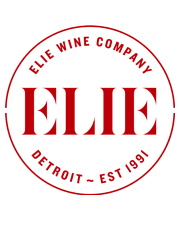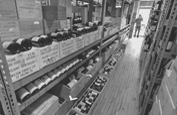3 Outstanding Producers in ‘Tuscany of the Gironde’: Fronsac’s Exceptional Terroir in St-Émilion-Pomerol Backyard. (9-Bottle Pack $286, All Included)
When arguing political ideologues, it’s wise to remember that the left wing and the right wing are part of the same bird; likewise, in Bordeaux, the Left Bank and the Right Bank refer to the same river system. In southwest France, about forty miles from the Atlantic, the Dordogne and Garonne rivers join to form the Gironde estuary; land below the confluence, between the two rivers, is known as Entre-Deux-Mers. Appellations on the west side of this system constitute the Left Bank, and contain perhaps Bordeaux’s most famous châteaux, those of the Médoc, Graves and Sauternes. Topsoil in this region is generally gravelly with a layer of limestone below and Cabernet Sauvignon is the dominant variety, producing age-demanding reds with big tannic infrastructures. The Right Bank covers the region to the north and east of the Gironde, where terroir contains less gravel and more clay. This allows Merlot to realize its purest potential, generally producing softer, richer and less tannic wines.
 The Right Bank itself boasts a number of exalted châteaux, of course, especially within Saint-Émilion and Pomerol. But it also contains phenomenal, lesser-known ‘satellite’ appellations which—in part by existing within the fame-shadow of Right Bank superstars like Château Angélus and Cheval Blanc—produce excellent wine whose prices are more in accord with content. One such example is Fronsac, known as ‘the Tuscany of the Gironde’ for its spectacular hillside vineyards overlooking the gentle Dordogne and the river Isle. The wines of Fronsac are exclusively red, usually Merlot-based and grown in ‘molasse du Fronsadais’—a subsoil composed of clay and more consistent limestone than neighboring St. Émilion. There are around a hundred winemakers currently at work throughout Fronsac’s two thousand vinous acres, and a renaissance in technique and focus throughout the region has raised the quality level of Fronsac wines to a level to which pricing has not yet caught up.
The Right Bank itself boasts a number of exalted châteaux, of course, especially within Saint-Émilion and Pomerol. But it also contains phenomenal, lesser-known ‘satellite’ appellations which—in part by existing within the fame-shadow of Right Bank superstars like Château Angélus and Cheval Blanc—produce excellent wine whose prices are more in accord with content. One such example is Fronsac, known as ‘the Tuscany of the Gironde’ for its spectacular hillside vineyards overlooking the gentle Dordogne and the river Isle. The wines of Fronsac are exclusively red, usually Merlot-based and grown in ‘molasse du Fronsadais’—a subsoil composed of clay and more consistent limestone than neighboring St. Émilion. There are around a hundred winemakers currently at work throughout Fronsac’s two thousand vinous acres, and a renaissance in technique and focus throughout the region has raised the quality level of Fronsac wines to a level to which pricing has not yet caught up.
Three Fronsac producers stand out in the production of strikingly consistent wines; examples not only of Fronsac but of Right Bank wines in general. This 9-Bottle Pack ($286, All Included) contains three bottles of each, for cellaring or enjoying today.
Château La Vieille Cure
 Foreign ownership is by no means rare in Fronsac; fully 13% of the châteaux are owned by Chinese investors—a higher percentage than any other Bordeaux wine appellation. Although La Vieille Cure has been producing wine since the 17th century, it was purchased by Americans Colin Ferenbach and Peter Sachs in 1986, and renovations began at once, including replanting a large portion of the 60 acres, all contained within a single plot. Those vines (75% Merlot, 22% Cabernet Franc and 3% Cabernet Sauvignon) are now in full maturity along with the estate’s older vine rows, where some of the Merlot vines are nearly a century old. This attention to detail and tradition shows, especially in this grand vin, making it one of the most prominent names in Fronsac. Under the direction of winemaker Jean Luc Thunevin, of the famed gem Château Valandraud, since 2013, the 2017 Château La Vieille Cure ($36)—a vintage many thought was lost due to a late-April frost—is a beautiful, balanced wine filled with ripe cherry, violets, licorice and vanilla, proving that the resilience of experience that can seize victory from the jaws of defeat.
Foreign ownership is by no means rare in Fronsac; fully 13% of the châteaux are owned by Chinese investors—a higher percentage than any other Bordeaux wine appellation. Although La Vieille Cure has been producing wine since the 17th century, it was purchased by Americans Colin Ferenbach and Peter Sachs in 1986, and renovations began at once, including replanting a large portion of the 60 acres, all contained within a single plot. Those vines (75% Merlot, 22% Cabernet Franc and 3% Cabernet Sauvignon) are now in full maturity along with the estate’s older vine rows, where some of the Merlot vines are nearly a century old. This attention to detail and tradition shows, especially in this grand vin, making it one of the most prominent names in Fronsac. Under the direction of winemaker Jean Luc Thunevin, of the famed gem Château Valandraud, since 2013, the 2017 Château La Vieille Cure ($36)—a vintage many thought was lost due to a late-April frost—is a beautiful, balanced wine filled with ripe cherry, violets, licorice and vanilla, proving that the resilience of experience that can seize victory from the jaws of defeat.
Château Villars
 Through two centuries and seven generations of vignerons, a single family has seen this estate through the thick of mid-18th century (when the wines of Fronsac rivaled those from nearby Saint-Émilion and Pomerol in both price and reputation) to the thin of the phylloxera plague of 1850 – 1870 which saw many of the hillside vineyards abandoned or neglected. Octave Trocard, at the helm of Villars at the turn of the 20th century, having won a gold medal at the 1907 World’s Fair in Antwerp, perished in World War I and left the property to his two daughters. It was their tutor who looked after the estate until the girls came of age, and in 1934, the eldest daughter married Jean-Jacques Gaudrie, who set about a quest to recapture the château’s impressive past. That involved purchasing neighboring vineyards with old vines and, after 1978, oak aging to the specifications of Bordeaux’s Classified Growths. 2015 was a fine vintage with none of the late-season frost that dogged 2017, and 2015 Château Villars ($25) shows a plush core of sweet mulberry, a complex mid-palate with red fruit and flowers and a slight tinge of clove on the finish.
Through two centuries and seven generations of vignerons, a single family has seen this estate through the thick of mid-18th century (when the wines of Fronsac rivaled those from nearby Saint-Émilion and Pomerol in both price and reputation) to the thin of the phylloxera plague of 1850 – 1870 which saw many of the hillside vineyards abandoned or neglected. Octave Trocard, at the helm of Villars at the turn of the 20th century, having won a gold medal at the 1907 World’s Fair in Antwerp, perished in World War I and left the property to his two daughters. It was their tutor who looked after the estate until the girls came of age, and in 1934, the eldest daughter married Jean-Jacques Gaudrie, who set about a quest to recapture the château’s impressive past. That involved purchasing neighboring vineyards with old vines and, after 1978, oak aging to the specifications of Bordeaux’s Classified Growths. 2015 was a fine vintage with none of the late-season frost that dogged 2017, and 2015 Château Villars ($25) shows a plush core of sweet mulberry, a complex mid-palate with red fruit and flowers and a slight tinge of clove on the finish.
Château de La Dauphine
 Nestled in the heart of the fiefdom where Charlemagne once built fortresses, the history of Château de La Dauphine is as saturated as it wines. It takes its name from Maria Josepha of Saxony, the Dauphine of France and the mother of Louis XVI, who stayed at the château shortly after its completion in 1750. In 1985, the last descendant of the original owners sold the property to the Moueix family of Pétrus, Château Trotanoy and Magdeleine fame. In 2000, it was acquired by the Halley family and then, in 2015, by the Labrunes; in the meantime, major renovations have been made to both the estate and the winemaking facilities, and with the assistance of the winemaker Michel Rolland, to ensure that the glory days of the past are recreated in the present. 2015 Château de La Dauphine ($29) displays cassis and violet on the nose, velvet-rich plum jam in the body, and well integrated tannins throughout a long, supple finish.
Nestled in the heart of the fiefdom where Charlemagne once built fortresses, the history of Château de La Dauphine is as saturated as it wines. It takes its name from Maria Josepha of Saxony, the Dauphine of France and the mother of Louis XVI, who stayed at the château shortly after its completion in 1750. In 1985, the last descendant of the original owners sold the property to the Moueix family of Pétrus, Château Trotanoy and Magdeleine fame. In 2000, it was acquired by the Halley family and then, in 2015, by the Labrunes; in the meantime, major renovations have been made to both the estate and the winemaking facilities, and with the assistance of the winemaker Michel Rolland, to ensure that the glory days of the past are recreated in the present. 2015 Château de La Dauphine ($29) displays cassis and violet on the nose, velvet-rich plum jam in the body, and well integrated tannins throughout a long, supple finish.
- - -
Posted on 2021.05.18 in France, Bordeaux | Read more...
France’s Central-Loire Sauvignon Blanc & Pinot Noir: White, Red …. and Rosé for Your Mom, Sancerre-ly. (6-Bottle Pack $298, All Included)
The languid Loire is the longest river in France, and its winemaking locus, occasionally interspersed with cereal crops, covers almost 200,000 acres. Originating in the south—virtually in the Rhône appellation—the river scrambles up through Orléans and hooks toward Tours in the country’s heartland. It is along this final leg, tracing the Loire’s path to the Atlantic, that some of the country’s most heralded wines are born; wines that, during the Middle Ages, were even more highly prized than those of Bordeaux or Burgundy. With a few exceptions, these wines were white, and those of Pouilly Fumé and especially Sancerre have earned a reputation as world ambassadors for French Sauvignon Blanc. As the climate warms, however, more attention is being focused on the Pinot Noir-based reds and crisply aromatic rosés that the Central Loire is increasingly able to produce.
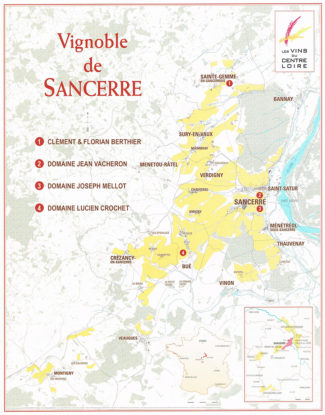 Separated only by the width of the river, Sancerre overlooks Pouilly Fumé with a sort of supercilious smirk. Sancerre’s interpretation of Sauvignon Blanc tends to more finessed, showing less minerality and more fruit than Pouilly Fumé, less flint-spark smoke and more flowering herb aromas and tastes without being as aggressively citrusy or grassy. This is a generalization, of course. Sancerre is comprised of a varied geology, and wines from individual terroirs express one-of-a-kind characteristics. To the east, flinty soils produce wines of almost steel-like elegance and austerity; the central vineyards are chalky and the wines are more floral and delicate and almost Chablis-like, while in the gravelly northwest, Sancerre tends to reflect an array of unusual fruits, many exotic—passion fruit, quince and lychee. All three plead a pretty respectable case that— Marlborough, Willamette and Graves notwithstanding—Sancerre is Sauvignon Blanc’s purest sanctuary. In ways, throughout Loire’s culture, purity is the hallmark, and the folks who live here are reputed to have the purest of all French accents.
Separated only by the width of the river, Sancerre overlooks Pouilly Fumé with a sort of supercilious smirk. Sancerre’s interpretation of Sauvignon Blanc tends to more finessed, showing less minerality and more fruit than Pouilly Fumé, less flint-spark smoke and more flowering herb aromas and tastes without being as aggressively citrusy or grassy. This is a generalization, of course. Sancerre is comprised of a varied geology, and wines from individual terroirs express one-of-a-kind characteristics. To the east, flinty soils produce wines of almost steel-like elegance and austerity; the central vineyards are chalky and the wines are more floral and delicate and almost Chablis-like, while in the gravelly northwest, Sancerre tends to reflect an array of unusual fruits, many exotic—passion fruit, quince and lychee. All three plead a pretty respectable case that— Marlborough, Willamette and Graves notwithstanding—Sancerre is Sauvignon Blanc’s purest sanctuary. In ways, throughout Loire’s culture, purity is the hallmark, and the folks who live here are reputed to have the purest of all French accents.
Sancerre wishes for a Happy Mother’s Day with a 6-Bottle Pack ($298, All Included) of each of the Central Loire Sauvignon Blanc & Pinot Noir: White, Red …. and Rosé
Domaine Jean Vacheron
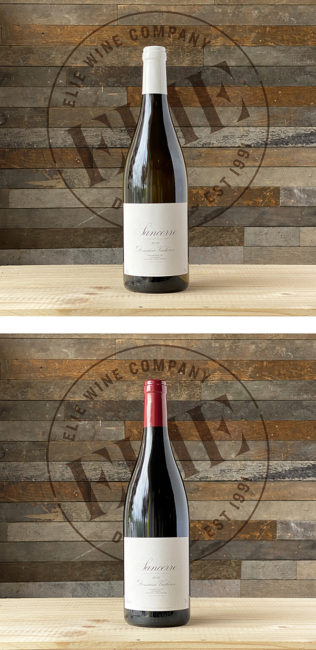 With over a hundred biodynamically-farmed acres and vines with an average age approaching half a century, Vacheron is one of the elite properties in Sancerre and cousins Jean-Laurent and Jean-Dominique Vacheron are among the top artisan winemakers in the Loire. Focused on single vineyard sites while hand-harvesting fruit, the Vacherons have produced primarily Sauvignon Blanc, but are also winning high marks for the twenty-five acres of chalk and silex that they have planted to Pinot Noir. These reds undergo malolactic after primary fermentation in foudres and neutral barriques, softening the acids and showcasing the fruit. The two wines in the package are exemplary both of the Vacheron style and of the appellation. Sancerre White 2019 ($46)displays a bright bouquet of Bosc pear, lime and dried yellow flowers and a rich, mouthwatering palate of citrus and sage with an edge of minerality. Sancerre Red 2018 ($56) highlights the warm vintage, which was especially kind to Pinot Noir, and produced a full-bodied wine that reflects warm cranberry, strawberry compote and tart cherry notes along with taut tannins that form a supple backbone.
With over a hundred biodynamically-farmed acres and vines with an average age approaching half a century, Vacheron is one of the elite properties in Sancerre and cousins Jean-Laurent and Jean-Dominique Vacheron are among the top artisan winemakers in the Loire. Focused on single vineyard sites while hand-harvesting fruit, the Vacherons have produced primarily Sauvignon Blanc, but are also winning high marks for the twenty-five acres of chalk and silex that they have planted to Pinot Noir. These reds undergo malolactic after primary fermentation in foudres and neutral barriques, softening the acids and showcasing the fruit. The two wines in the package are exemplary both of the Vacheron style and of the appellation. Sancerre White 2019 ($46)displays a bright bouquet of Bosc pear, lime and dried yellow flowers and a rich, mouthwatering palate of citrus and sage with an edge of minerality. Sancerre Red 2018 ($56) highlights the warm vintage, which was especially kind to Pinot Noir, and produced a full-bodied wine that reflects warm cranberry, strawberry compote and tart cherry notes along with taut tannins that form a supple backbone.
Domaine Joseph Mellot
 Domaine Joseph Mellot is unique as the only estate in the Central Loire to own vineyards in all the appellations—Sancerre, Pouilly-Fumé, Pouilly-sur-Loire, Coteaux du Giennois, Menetou Salon, Quincy, Reuilly and Châteaumeillant. Founded in Quincy in 1513, it has been associated with quality Sancerre for over five hundred years. Under the leadership of Catherine Corbeau-Mellot, who has been up-shaping her wines on the path of excellence for the past thirty years, the property has established modern innovations where appropriate, while maintaining its half-millennia of tradition. ‘La Chatellenie’ Sancerre White 2019 ($26) is grown on ‘typical’ flint-rich Sancerre soils, and displays a lively, lovely green apple nose above a core palate of gooseberries, melon, spearmint and nettles. The warm summer of 2019 allowed the fruit to ripen in a lushness that rounds off the bracing acidity that Sauvignon Blanc often expresses in the Loire.
Domaine Joseph Mellot is unique as the only estate in the Central Loire to own vineyards in all the appellations—Sancerre, Pouilly-Fumé, Pouilly-sur-Loire, Coteaux du Giennois, Menetou Salon, Quincy, Reuilly and Châteaumeillant. Founded in Quincy in 1513, it has been associated with quality Sancerre for over five hundred years. Under the leadership of Catherine Corbeau-Mellot, who has been up-shaping her wines on the path of excellence for the past thirty years, the property has established modern innovations where appropriate, while maintaining its half-millennia of tradition. ‘La Chatellenie’ Sancerre White 2019 ($26) is grown on ‘typical’ flint-rich Sancerre soils, and displays a lively, lovely green apple nose above a core palate of gooseberries, melon, spearmint and nettles. The warm summer of 2019 allowed the fruit to ripen in a lushness that rounds off the bracing acidity that Sauvignon Blanc often expresses in the Loire.
Domaine Lucien Crochet
 A match made in Sancerre heaven? Lucien Crochet’s marriage to the daughter of Lucien Picard fused not only families, but wine estates; Crochet expanded the work of his father-in-law and, over the next forty years, grew the domain until it encompassed sixty acres of vineyards, nearly all in the village of Bué, but with smaller holdings in the neighboring villages of Vinon and Crézancy. Under the management of his son Gilles, Crochet’s vineyards are planted on shallow clay and limestone soil and on south-facing slopes of varying degrees of severity. The Sauvignon Blanc is fermented in stainless steel to preserve its freshness and clarity; the Pinot Noir macerates for thirty days before seeing 70% oak aging. ‘Le Chêne Marchand’ Sancerre White 2018 ($43) is a stellar example of Sancerre’s shivery, sculpted, steely character. Sharp, with intense minerality reminiscent of crushed rocks, it provides ample stone-fruit in the mid-palate to sweeten the tartness and finishes as clean as the air after summer rain. ‘Cuvée Prestige’ Sancerre Red 2015 ($83) is bright and rich, showing elegant blackberry and blueberry notes with soft vanilla wreathing the fruit’s silken tannins to form a foundation of sophistication and maturity.
A match made in Sancerre heaven? Lucien Crochet’s marriage to the daughter of Lucien Picard fused not only families, but wine estates; Crochet expanded the work of his father-in-law and, over the next forty years, grew the domain until it encompassed sixty acres of vineyards, nearly all in the village of Bué, but with smaller holdings in the neighboring villages of Vinon and Crézancy. Under the management of his son Gilles, Crochet’s vineyards are planted on shallow clay and limestone soil and on south-facing slopes of varying degrees of severity. The Sauvignon Blanc is fermented in stainless steel to preserve its freshness and clarity; the Pinot Noir macerates for thirty days before seeing 70% oak aging. ‘Le Chêne Marchand’ Sancerre White 2018 ($43) is a stellar example of Sancerre’s shivery, sculpted, steely character. Sharp, with intense minerality reminiscent of crushed rocks, it provides ample stone-fruit in the mid-palate to sweeten the tartness and finishes as clean as the air after summer rain. ‘Cuvée Prestige’ Sancerre Red 2015 ($83) is bright and rich, showing elegant blackberry and blueberry notes with soft vanilla wreathing the fruit’s silken tannins to form a foundation of sophistication and maturity.
Clément & Florian Berthier
 Like many French wine estates, Domaine Berthier is a family affair. Founded in the early 1980s by Jean-Marie Berthier near Sainte-Gemme-en-Sancerrois, his wife’s hometown, the couple took over the Domaine de Montbenoit in the Coteaux du Giennois, one of the smallest AOPs in the Loire. The domain is now run by brothers Florian and Clément, who combined strengths to maintain sixty acres to their parents’ standards; Florian first honed his skills in vineyard management in Burgundy while his elder brother Clément studied winemaking in Canada and in the United States. Today, they produce a number of wines from a variety of terroirs, none more remarkable than that salmon-colored, fruit-forward Sancerre Rosé 2019 ($27), made entirely from Pinot Noir grown on slopes along the ancient river terraces at Gien. The wine is juicy and crisp with strong notes of peach blossom, honeysuckle and wild strawberry; a delightful afternoon sipping wine.
Like many French wine estates, Domaine Berthier is a family affair. Founded in the early 1980s by Jean-Marie Berthier near Sainte-Gemme-en-Sancerrois, his wife’s hometown, the couple took over the Domaine de Montbenoit in the Coteaux du Giennois, one of the smallest AOPs in the Loire. The domain is now run by brothers Florian and Clément, who combined strengths to maintain sixty acres to their parents’ standards; Florian first honed his skills in vineyard management in Burgundy while his elder brother Clément studied winemaking in Canada and in the United States. Today, they produce a number of wines from a variety of terroirs, none more remarkable than that salmon-colored, fruit-forward Sancerre Rosé 2019 ($27), made entirely from Pinot Noir grown on slopes along the ancient river terraces at Gien. The wine is juicy and crisp with strong notes of peach blossom, honeysuckle and wild strawberry; a delightful afternoon sipping wine.
- - -
Posted on 2021.05.08 in France, Loire | Read more...
Appellation Côtes du Rhône Reds from Five Top Châteauneuf-du-Pape Domaines: Just as AMBITIOUS! (10-Bottle Pack $299, All Included)
Many a storied French château can trace their origins to the Romans—far fewer can boast a heritage dating back to the Greeks. But Marseilles—founded in the Sixth Century BCE as Massalia—is a scant seventy miles south of Châteauneuf-du-Pape, and it was through this ancient port that the Ionian Greeks brought France some of her earliest vines. The Ligurian Celts who occupied Southern Rhône were producing wine five centuries before Julius Caesar drew his first breath.
Although Châteauneuf-du-Pape remains her heart and soul, Southern Rhône slithers across a vast, fecund territory, producing 95% of Rhône Valley’s total wine output. It follows a vinous path beginning in the commune of Montélimar, about 30 miles south of Valence, and extends to the medieval city of Avignon, once the seat of the Catholic popes. The climate here is considerably warmer than it is along the Rhône’s northern banks, and the favored grape varieties are those that thrive best through hot and humid summers. Unlike its northerly neighbor, which relies heavily (and at times entirely) on Syrah, wines from the south are generally blends based on a balance of viniculture’s Holy Trinity—Grenache, Syrah and Mourvèdre—along with a legion of other grapes. These wines often represent tremendous value as well as a diverse tasting experience comfortably described as ‘sunny’ because of the bright fruit and warm herb notes expressed.
Côtes du Rhône AOC is one of the largest single appellation regions in the world, covering millions of acres and producing millions of bottles of wine of varying degrees of quality. In Southern Rhône, it encompasses the majority of vineyards and includes hallowed names like Gigondas, Vacqueyras and Châteauneuf-du-Pape. The latter wines prefer to use their individual, highly specific ‘cru’ names, but the truth is, many generic Côtes du Rhônes may come from plots just outside official ‘Villages’ boundaries—some only across the road or a few vine rows away—and among them, you can find wines with nearly the same level of richness at a fraction of the cost.
Of course, there is more to being an acclaimed appellation than simply terroir; the top producers in the Côtes du Rhône also adhere to a highly restrictive set of rules involving everything from lower than allowed maximum yields per acre to minimum alcohol content without chaptalization to permitted varietals; the requirements for a generic Côtes du Rhône is much less stringent.
The best—and by most accounts, the most reliable—of the many Côtes du Rhône labels is the insignia-embossed Châteauneuf-du-Pape, which hails from a remarkable region between the towns of Orange and Avignon. Named for the castle built by the 14th Century Pope John XXII, this heavily-extracted wine is the template after which most Côtes du Rhône reds model themselves, and in fact, it’s the copycats that persuaded the producers of genuine Châteauneuf-du-Pape producers to apply to the French government to protect their name, making it the first AOC in France. The unique combination of precipitation (Châteauneuf-du-Pape is very dry) and wind (the cool, powerful Mistral blows from the northeast, down the Rhône Valley corridor, and into the Gulf of Lion in the northern Mediterranean) and especially, the large, flat stones known as galets which serve to prevent surface evaporation and reflect sunlight into the canopy. This happens to be conditions ideal for Grenache to realize full potential, and as a result, Châteauneuf-du-Pape is largely built around this grape, typically grown on low bush vines. Syrah adds black-fruit spice, and is grown on cooler higher ground; Mourvèdre brings flesh and acidity, and makes up about 10% of a typical blend. To a decreasing extent, Cinsault is used for aromatics; a total of 13 varieties are permitted, giving the wine a legendary and almost unrivaled complexity. Big-shouldered, occasionally blustery, Châteauneuf-du-Pape wine may, in ideal vintages, be as enjoyable to drink in its youth as it is with age. When young, a core of perfumed fruit tames the tannins and acidity, and tempers into rich leather and smoky, earth-tones as it grows older.
 Limited to five communes, Châteauneuf-du-Pape commands prices worthy of its reputation, but many of the estates own vines just outside the tight borders and there are some plots on which some vineyard rows may be labeled Châteauneuf-du-Pape and adjacent rows, Côtes du Rhône. The finest of these face the challenge of bureaucracy rather than terroir. We firmly believe that the following wines offer extraordinary ‘CdP-esque’ quality at a phenomenal price; they are suited to those who drink for the wine instead of the label. A 10-bottle pack, two of each, for an all-inclusive price of $299.
Limited to five communes, Châteauneuf-du-Pape commands prices worthy of its reputation, but many of the estates own vines just outside the tight borders and there are some plots on which some vineyard rows may be labeled Châteauneuf-du-Pape and adjacent rows, Côtes du Rhône. The finest of these face the challenge of bureaucracy rather than terroir. We firmly believe that the following wines offer extraordinary ‘CdP-esque’ quality at a phenomenal price; they are suited to those who drink for the wine instead of the label. A 10-bottle pack, two of each, for an all-inclusive price of $299.
Domaine de la Vieille Julienne
 Domaine de la Vieille Julienne’s Lieut-dit Clavin exists as a 50-acre plot at the northern limit of Châteauneuf-du-Pape, and indeed, the same vineyard that produces Châteauneuf-du-Pape “Les Trois Sources” (representing the three highest terraces of north-facing Clavin), and “Les Hauts-lieux” (representing the lower terraces), also produces Côtes du Rhône “Lieut-dit Clavin” ($36). A structured and beefy gem, the 2017 showcases dark tannins beneath beautiful, juicy fruit; there are rich and charming notes of blackcurrant jam, black and red licorice and a wreathe of plum and tobacco in an earthen core.
Domaine de la Vieille Julienne’s Lieut-dit Clavin exists as a 50-acre plot at the northern limit of Châteauneuf-du-Pape, and indeed, the same vineyard that produces Châteauneuf-du-Pape “Les Trois Sources” (representing the three highest terraces of north-facing Clavin), and “Les Hauts-lieux” (representing the lower terraces), also produces Côtes du Rhône “Lieut-dit Clavin” ($36). A structured and beefy gem, the 2017 showcases dark tannins beneath beautiful, juicy fruit; there are rich and charming notes of blackcurrant jam, black and red licorice and a wreathe of plum and tobacco in an earthen core.
Domaine Saint Préfert
 On the southern end of Châteauneuf-du-Pape, owner/winemaker Isabel Ferrando was (in her words) ‘born into the howling mistral winds and the singing cicadas.’ Those memories drew her to winemaking after a successful career in banking, and today, she produces wines that consistently score in the 90s. “Clos Beatus Ille” 2019 ($33) is her Côtes du Rhône label, and presents a luscious mouthfeel framed by firm, densely packed tannins and showing crushed red fruits, thyme with black tea and graphite notes.
On the southern end of Châteauneuf-du-Pape, owner/winemaker Isabel Ferrando was (in her words) ‘born into the howling mistral winds and the singing cicadas.’ Those memories drew her to winemaking after a successful career in banking, and today, she produces wines that consistently score in the 90s. “Clos Beatus Ille” 2019 ($33) is her Côtes du Rhône label, and presents a luscious mouthfeel framed by firm, densely packed tannins and showing crushed red fruits, thyme with black tea and graphite notes.
Domaine Pierre Usseglio & Fils
 Founded in 1948 by Italian winemaker Francis Usseglio, the domain released its first vintage the following year. Since then, the family has nurtured 17 parcels over almost fifty acres situated within some of the best terroirs in Châteauneuf-du-Pape, and today, brothers Jean-Pierre and Thierry Ussegliodivide their time between cellar and vineyards, updating technique without compromising the traditional style espoused by their father. They produce world-class Châteauneuf-du-Pape, but also, among the most refined Côtes du Rhône bottlings to be found, especially in this rare and benchmark vintage. The Côtes du Rhône 2016 ($26) is chewy and delectable, with bright red mulberry notes above garrigue and smoke.
Founded in 1948 by Italian winemaker Francis Usseglio, the domain released its first vintage the following year. Since then, the family has nurtured 17 parcels over almost fifty acres situated within some of the best terroirs in Châteauneuf-du-Pape, and today, brothers Jean-Pierre and Thierry Ussegliodivide their time between cellar and vineyards, updating technique without compromising the traditional style espoused by their father. They produce world-class Châteauneuf-du-Pape, but also, among the most refined Côtes du Rhône bottlings to be found, especially in this rare and benchmark vintage. The Côtes du Rhône 2016 ($26) is chewy and delectable, with bright red mulberry notes above garrigue and smoke.
Domaine Charvin
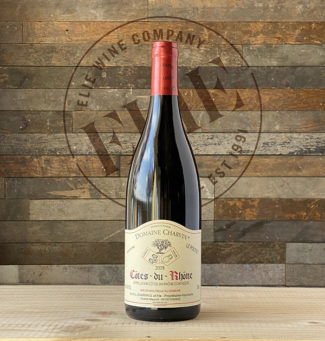 Laurent Charvin tends vines in the northwest end of Châteauneuf-du-Pape, primarily in Cabrières, Maucoil and Mont Redon. He farms organically, and vinifies old-school, without de-stemming and fermenting in concrete tanks for 21 months before being bottled unfiltered. From a sandy, north-facing hillside, “Le Poutet” 2018 ($26) is an exemplary Côtes du Rhône that shows Grenache elegance with ripe blackberry and mulberry mingled in bramble and spice. The palate is intense and generous and is wonderful testimony to the winemaker’s attention to detail.
Laurent Charvin tends vines in the northwest end of Châteauneuf-du-Pape, primarily in Cabrières, Maucoil and Mont Redon. He farms organically, and vinifies old-school, without de-stemming and fermenting in concrete tanks for 21 months before being bottled unfiltered. From a sandy, north-facing hillside, “Le Poutet” 2018 ($26) is an exemplary Côtes du Rhône that shows Grenache elegance with ripe blackberry and mulberry mingled in bramble and spice. The palate is intense and generous and is wonderful testimony to the winemaker’s attention to detail.
Domaine Chante Cigale
 The roots of this domain extend back to 1874, when the delightfully-named Hyppolite Jourdan christened the estate Chante Cigale, meaning ‘song of the cicada’, as can be heard throughout Southern Rhône. Alexandre Favier currently runs the winery—now expanded to nearly a hundred acres—maintaining the family’s winemaking traditions. “Vieilles Vignes” 2017 ($20) is a showy Côtes du Rhône packed with plush blackberry and rounded blueberry on the palate, with smoky notes in the mid-palate edged by minerality, bright acidity and fine-grained tannins.
The roots of this domain extend back to 1874, when the delightfully-named Hyppolite Jourdan christened the estate Chante Cigale, meaning ‘song of the cicada’, as can be heard throughout Southern Rhône. Alexandre Favier currently runs the winery—now expanded to nearly a hundred acres—maintaining the family’s winemaking traditions. “Vieilles Vignes” 2017 ($20) is a showy Côtes du Rhône packed with plush blackberry and rounded blueberry on the palate, with smoky notes in the mid-palate edged by minerality, bright acidity and fine-grained tannins.
- - -
Posted on 2021.04.29 in France, Wine-Aid Packages, Southern Rhone | Read more...
Domaine Yves Cuilleron: Northern Rhône’s Syrah Articulated in Four Types + Viognier + Marsanne (6-Bottle Pack $299, All Included)
 Just beneath the ancient city of Lyon, the Rhône River does a rakehell turn westward, then at Vienne, another turn toward the east before again heading south. That’s where you stumble upon the first vines of the Northern Rhône, many planted on steep hillsides and most of them on the river’s right bank. Côte-Rôtie—the ‘Roasted Slope’—is the northernmost appellation within the Rhône Valley and renowned for these terraced, river-hugging vineyards. Syrah reigns in Côte-Rôtie, but not supreme: Appellation rules allow for the addition of up to 20% Viognier, adding to the wine’s characteristic aroma of flowers and leather. Viognier’s true kingdom is just below Côte-Rôtie, in Condrieu—a winding nine-mile stretch of vineyards—where this aromatic, peach-scented white wine is produced in Lilliputian quantities to Brobdingnagian applause. Further south, Syrah regains its foothold: Although the sprawling mega-appellation of Saint-Joseph may, like Côte-Rôtie, blend white varietals into their red wine, and white Hermitage, white Crozes-Hermitage and Saint-Péray are all made from Marsanne/Roussanne, the vast majority of Northern Rhône is given over to the production of Syrah. This may range from tiny, under-appreciated Cornas to elevated, perhaps over-appreciated Hermitage. Below Northern Rhône is a different wine world entirely; Southern Rhône is warmer and flatter and employs multiple varietals to create wines essentially unlike those of their northern neighbors.
Just beneath the ancient city of Lyon, the Rhône River does a rakehell turn westward, then at Vienne, another turn toward the east before again heading south. That’s where you stumble upon the first vines of the Northern Rhône, many planted on steep hillsides and most of them on the river’s right bank. Côte-Rôtie—the ‘Roasted Slope’—is the northernmost appellation within the Rhône Valley and renowned for these terraced, river-hugging vineyards. Syrah reigns in Côte-Rôtie, but not supreme: Appellation rules allow for the addition of up to 20% Viognier, adding to the wine’s characteristic aroma of flowers and leather. Viognier’s true kingdom is just below Côte-Rôtie, in Condrieu—a winding nine-mile stretch of vineyards—where this aromatic, peach-scented white wine is produced in Lilliputian quantities to Brobdingnagian applause. Further south, Syrah regains its foothold: Although the sprawling mega-appellation of Saint-Joseph may, like Côte-Rôtie, blend white varietals into their red wine, and white Hermitage, white Crozes-Hermitage and Saint-Péray are all made from Marsanne/Roussanne, the vast majority of Northern Rhône is given over to the production of Syrah. This may range from tiny, under-appreciated Cornas to elevated, perhaps over-appreciated Hermitage. Below Northern Rhône is a different wine world entirely; Southern Rhône is warmer and flatter and employs multiple varietals to create wines essentially unlike those of their northern neighbors.
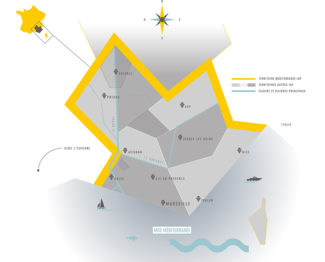 Of more than passing note (driven in part by its affordability) is the Collines Rhodaniennes IGP which encompasses all of Northern Rhône, but represents country wines built not on tradition or AOC (relabeled AOP ‘Appellation d’Origine Protégée’ by the European Union) rules, but rely solely on geographical origin. Thus, IGP wines (Indication Géographique Protégée) afford winemakers considerably more freedom to experiment, and often represent remarkable values from historical, ever-improving sites.
Of more than passing note (driven in part by its affordability) is the Collines Rhodaniennes IGP which encompasses all of Northern Rhône, but represents country wines built not on tradition or AOC (relabeled AOP ‘Appellation d’Origine Protégée’ by the European Union) rules, but rely solely on geographical origin. Thus, IGP wines (Indication Géographique Protégée) afford winemakers considerably more freedom to experiment, and often represent remarkable values from historical, ever-improving sites.
The six-bottle package contains one bottle of each of Yves Cuilleron’s featured wines. The offer, comprising four red and two white wines, is for $299 and all included.
Domaine Yves Cuilleron
Wine has been grown in Northern Rhône for millennia; to it, the Cuilleron family has been lending their spirited interpretation for many generations. Founded in 1920 in the heart of Saint-Joseph, the family has been producing commercial wine since 1947, with the current owner Yves taking the helm in 1987. He expanded the domaine’s holding to 130 acres, incorporating vineyards in Condrieu, Saint Joseph Rouge and Blanc, Cote Rôtie and Saint Péray.

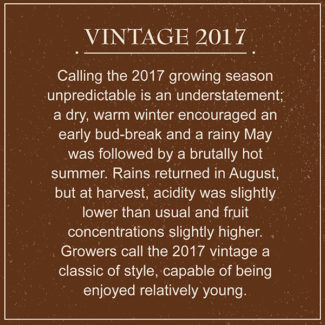 “The majority of our vineyards are set on terraces, making mechanization nearly impossible,” Yves maintains. “Thus, as has been done here for thousands of years, much of the vineyard work is to be done by hand. To control yields, we do extensive de-budding and, when necessary, practice ‘green harvests’ by removing extra grape bunches and balancing leaf area and fruit weight to achieve better ripeness.”
“The majority of our vineyards are set on terraces, making mechanization nearly impossible,” Yves maintains. “Thus, as has been done here for thousands of years, much of the vineyard work is to be done by hand. To control yields, we do extensive de-budding and, when necessary, practice ‘green harvests’ by removing extra grape bunches and balancing leaf area and fruit weight to achieve better ripeness.”
Côte-Rôtie
 Northern Rhône’s ‘roasted slope’ is actually a series of sun-harvesting slopes that rise a thousand feet above the Rhône and surround the small town of Ampuis. Despite producing what is arguably the ‘ultimate’ Syrah, the classic black-fruit and bacon aromatics of Côte-Rôtie are often enhanced with the addition of Viognier. Named for the stream that flows at the base of Domaine Yves Cuilleron’s Côte-Rôtie ten acres, “Madinière” 2017 Red ($69) is sweet and dense, showing notes of olive and spice and a savory, mineral-driven palate. Total Production: 1,550 cases.
Northern Rhône’s ‘roasted slope’ is actually a series of sun-harvesting slopes that rise a thousand feet above the Rhône and surround the small town of Ampuis. Despite producing what is arguably the ‘ultimate’ Syrah, the classic black-fruit and bacon aromatics of Côte-Rôtie are often enhanced with the addition of Viognier. Named for the stream that flows at the base of Domaine Yves Cuilleron’s Côte-Rôtie ten acres, “Madinière” 2017 Red ($69) is sweet and dense, showing notes of olive and spice and a savory, mineral-driven palate. Total Production: 1,550 cases.
Cornas
 No Viognier is permitted in Cornas; this wine is Syrah in its most honest profile. Consisting of a mere 270 acres on the western bank of the Rhône just south of the Saint-Joseph appellation, the granite in the subsoil of Cornas retains heat while providing rapid drainage, forcing the vines to form deep root systems. “Le Village” 2017 Red ($53)originates in three plots behind the Cornas village church (in the districts of Les Côtes and Reynard), and provides a wine with an electric core of acidity and a foreground taut with raspberry and plum along with toasted, cedary, smoky tannin. Total Production: 66 cases.
No Viognier is permitted in Cornas; this wine is Syrah in its most honest profile. Consisting of a mere 270 acres on the western bank of the Rhône just south of the Saint-Joseph appellation, the granite in the subsoil of Cornas retains heat while providing rapid drainage, forcing the vines to form deep root systems. “Le Village” 2017 Red ($53)originates in three plots behind the Cornas village church (in the districts of Les Côtes and Reynard), and provides a wine with an electric core of acidity and a foreground taut with raspberry and plum along with toasted, cedary, smoky tannin. Total Production: 66 cases.
Saint-Joseph
 Saint-Joseph covers a lot of territory and multiple terroirs; it encompasses 26 communes and stretches from Chavanay in the north to Châteaubourg in the south, roughly 30 miles in length. The reds from the region can be light for Rhônes, a result of soils containing less granite and vines that face east rather than south. But in strong vintages, they are spectacular. “Cavanos”2017 Red ($37) shows an inky, dark red color, and as this might suggest, it is fully fruit forward with smoke and spicy cherry notes, tobacco and burning leaves on the nose and medium-low tannins. Total Production: 2,383 cases.
Saint-Joseph covers a lot of territory and multiple terroirs; it encompasses 26 communes and stretches from Chavanay in the north to Châteaubourg in the south, roughly 30 miles in length. The reds from the region can be light for Rhônes, a result of soils containing less granite and vines that face east rather than south. But in strong vintages, they are spectacular. “Cavanos”2017 Red ($37) shows an inky, dark red color, and as this might suggest, it is fully fruit forward with smoke and spicy cherry notes, tobacco and burning leaves on the nose and medium-low tannins. Total Production: 2,383 cases.
Crozes-Hermitage
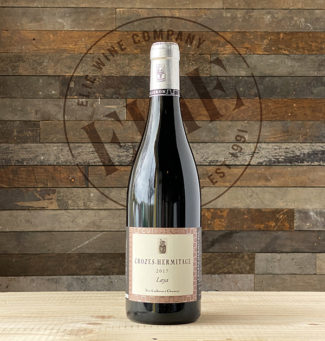 Crozes-Hermitage labors in the shadow of its storied namesake Hermitage, and has no pretentions of equality. Price reflects that, of course, and the wine itself does hold at least some measure of the magnificence found in its massive, long-lived neighbor. “Laya” 2017 Red ($32) is grown in 5 acres on the south of the Tain l’Hermitage commune on a plot called Malfondière. High-density planting (20,000 vines per acre) leads to an exceptional richness in the wine, complex but easy to drink. Blackberry and milk chocolate overlay licorice and black pepper with a bracing acidity, making it an ideal food wine. Total Production: 3,000 cases.
Crozes-Hermitage labors in the shadow of its storied namesake Hermitage, and has no pretentions of equality. Price reflects that, of course, and the wine itself does hold at least some measure of the magnificence found in its massive, long-lived neighbor. “Laya” 2017 Red ($32) is grown in 5 acres on the south of the Tain l’Hermitage commune on a plot called Malfondière. High-density planting (20,000 vines per acre) leads to an exceptional richness in the wine, complex but easy to drink. Blackberry and milk chocolate overlay licorice and black pepper with a bracing acidity, making it an ideal food wine. Total Production: 3,000 cases.
Condrieu
 Condrieu is a unique slice of wine country, both in Northern Rhône and arguably, in the entire wine world. Contained within seven parishes, Condrieu’s unique soil chemistry (mixed chalk, flint and mica) produces Viognier of world-renowned distinction, heavily perfumed and full-bodied. Northerly winds traveling up the river keep yields notoriously low; it’s an expensive wine to produce, and as a result, not much is made—for every bottle of Condrieu released, there are ten of Crôzes-Hermitage. “Les Chaillets”2017 White ($69) is the local name for terraces, and Cuilleron’s Condrieu is grown on mica-rich, south-facing vineyards, and picked from the best and oldest vines. Like all fine Condrieus, it is rich to the point of unctuousness and shows a bouquet almost ferocious in intensity, showing ripe peach, melon and honeyed almond. Condrieu is an ideal wine for seafood, especially scallops. Total Production: 1,191 cases.
Condrieu is a unique slice of wine country, both in Northern Rhône and arguably, in the entire wine world. Contained within seven parishes, Condrieu’s unique soil chemistry (mixed chalk, flint and mica) produces Viognier of world-renowned distinction, heavily perfumed and full-bodied. Northerly winds traveling up the river keep yields notoriously low; it’s an expensive wine to produce, and as a result, not much is made—for every bottle of Condrieu released, there are ten of Crôzes-Hermitage. “Les Chaillets”2017 White ($69) is the local name for terraces, and Cuilleron’s Condrieu is grown on mica-rich, south-facing vineyards, and picked from the best and oldest vines. Like all fine Condrieus, it is rich to the point of unctuousness and shows a bouquet almost ferocious in intensity, showing ripe peach, melon and honeyed almond. Condrieu is an ideal wine for seafood, especially scallops. Total Production: 1,191 cases.
Collines Rhodaniennes IGP
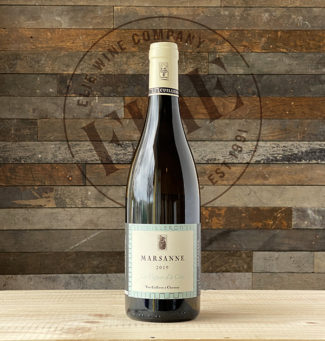 Marsanne is a grape perfectly suited to St-Joseph’s heralded “Terroir de Granit”—it ripens fully in the appellation’s continental climate where it obtains its characteristic deep gold color. This IGP “Les Vignes d’à Côté – Marsanne” 2019 White ($22) offers subtle notes of roasted nuts, oranges, figs and pronounced lemon peel; it is quite floral on the nose and crisply acidic in the mouth and should be consumed young. Total Production: 2,500 cases.
Marsanne is a grape perfectly suited to St-Joseph’s heralded “Terroir de Granit”—it ripens fully in the appellation’s continental climate where it obtains its characteristic deep gold color. This IGP “Les Vignes d’à Côté – Marsanne” 2019 White ($22) offers subtle notes of roasted nuts, oranges, figs and pronounced lemon peel; it is quite floral on the nose and crisply acidic in the mouth and should be consumed young. Total Production: 2,500 cases.
- - -
Posted on 2021.04.22 in France, Northern Rhone | Read more...
Cahors’ Argentine Revival: The Original Malbec by Four New Generation Producers. (12-Bottle Pack $286, All Included) – Saturday Sips
Carl Sandburg might have described Malbec as big-shouldered, stormy, husky and brawling. He might have called it coarse and strong and cunning. One thing is clear: Whether in its juicy, gentle incarnation in the Southwest of France or in its more tannic, voluminous and generous New World guise, Malbec is built to last.
At one time, Malbec was planted so widely across France that it has a thousand different regional names. In recent years, the somewhat austere quality of the wine and its sensitivity of the vines to frost and mildew have greatly reduced its overall acreage, although 11% of the world’s Malbec may still be found in Cahors. In Argentina, where it was first planted in 1868, it has become not only the country’s signature variety but the most widely grown red grape, with more than 77,000 acres planted to Malbec. In the foothills of the Andes—especially in the high-altitude regions of Luján de Cuyo and the Uco Valley—Malbec achieves an elevated status of its own. The drier atmosphere of the mountains all but eliminates the mildew scourge to which it is susceptible near sea level, and the limestone rich soils (notably in Gualtallary, Altamira and La Consulta) have helped built an international reputation for age-worthy gems that are also approachable in their youth.
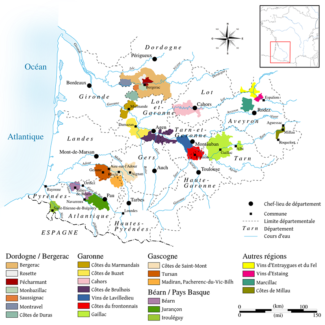
Despite the fashionable acclaim that South American Malbec has earned, the medieval city of Cahors in Southwest France will always be its spiritual home. First planted by the Romans and known locally as Côt or Auxerrois, the Malbec grape must make up a
minimum of 70% of any wine bearing the Appellation ‘Cahors’ on the label, with permissible blending grapes restricted to Tannat and Merlot—Cahors is unique in Southwest France in that it prohibits the use of Cabernet Sauvignon and Cabernet Franc. Since Malbec does not fully ripen until October, Cahors tends to be a September-driven wine and conditions the month before largely determine the success of the harvest. In lesser years, tannins compete with an acidic assault and dominate the palate. But in fine vintages like 2015 and 2018, the wine is a nice balance of rich wood and herbal fruit with dark chocolate and licorice flavors sidling in behind softer tannins. This holds especially true for the new generation of Cahors producers, who have reclaimed Malbec as their prize and applied rigorous natural farm practices and techniques to produce wines far more voluptuous and velvety in their youth than was exhibited by the best of their forebears.
The twelve-bottle pack offer, at $286 and all included, contains three bottles of each of the first four featured wines. Separately, we are offering a special cuvée “Géron Dadine de Haute-Serre” from Georges Vigouroux’s Château de Haute-Serre, at a deeply discounted price.
Château de Marcuès “Grand Vin Seigneur” 2015 ($28)
 When he bought Château de Mercuès in 1983, Georges Vigouroux’s main focus was restructuring the vineyards on the gravely hillocks above the communes of Caillac and Mercuès; the fact that he also restored the 13th-century castle on the estate was icing on the cake. The turreted château is now hotel, where guests are encouraged to take part in the harvest and vinification process. Among the changes Vigouroux brought to the replanted vineyards was an increased vine density, a technique used by the great châteaux of the Médoc. It reduces yields and increases concentration in the wines. Like the hotel, “Grand Vin Seigneur” is luxurious and supple behind a solid exterior. It shows cassis and black cherry beneath a granitic nose, with wood smoke and black pepper at the finish.
When he bought Château de Mercuès in 1983, Georges Vigouroux’s main focus was restructuring the vineyards on the gravely hillocks above the communes of Caillac and Mercuès; the fact that he also restored the 13th-century castle on the estate was icing on the cake. The turreted château is now hotel, where guests are encouraged to take part in the harvest and vinification process. Among the changes Vigouroux brought to the replanted vineyards was an increased vine density, a technique used by the great châteaux of the Médoc. It reduces yields and increases concentration in the wines. Like the hotel, “Grand Vin Seigneur” is luxurious and supple behind a solid exterior. It shows cassis and black cherry beneath a granitic nose, with wood smoke and black pepper at the finish.
Clos Troteligotte “K-or” 2018 ($23)
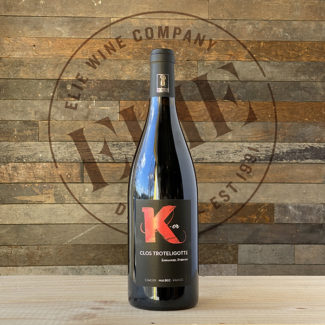 Emmanuel Rybinsky is one of the emblematic young stars of the ‘new’ Cahors; with 29 acres planted above the fog-line—and thus, safe from mildew—he is creating terroir-driven wines from small parcels within a unique plateau of iron-rich limestone in the village of Villesèque. Planted in 1987 by Emmanuel’s father, K-or is one such plot, a mere 2.5 acre. The wine is 100% Malbec; Emmanuel gushes over the ‘bloody’ aromas, which no doubt refers to the pronounced iron minerality in the nose. This is the most aggressively aromatic wine in his collection with a smoky, roasted edge to the black currant and plum; the mouth is both savory and spicy and fronts a marvelous tannic backbone.
Emmanuel Rybinsky is one of the emblematic young stars of the ‘new’ Cahors; with 29 acres planted above the fog-line—and thus, safe from mildew—he is creating terroir-driven wines from small parcels within a unique plateau of iron-rich limestone in the village of Villesèque. Planted in 1987 by Emmanuel’s father, K-or is one such plot, a mere 2.5 acre. The wine is 100% Malbec; Emmanuel gushes over the ‘bloody’ aromas, which no doubt refers to the pronounced iron minerality in the nose. This is the most aggressively aromatic wine in his collection with a smoky, roasted edge to the black currant and plum; the mouth is both savory and spicy and fronts a marvelous tannic backbone.
Château du Cèdre “Cèdre Héritage” 2018 ($23)
 Pascal and Jean-Marc Verhaeghe are brothers and collaborators. Having inherited the 67-acre Château du Cèdre from their father Charles, Pascal assumed vinification and marketing duties while Jean-Marc manages the vineyard. The estate contains two distinct soil types; limestone-rich scree and ancient, heavier alluvial deposits containing clay, pebbles (galets roulés) and sand. Like the brothers, these two terroirs function both separately and in communion, producing wines with elegance and style while maintaining the rustic earthiness of Malbec. “Cèdre Héritage” is a wine best described as energetic, saturated with lively aromatics of spice and herbs leading to an impeccable balance of tannin, acidity and forward, plush fruit.
Pascal and Jean-Marc Verhaeghe are brothers and collaborators. Having inherited the 67-acre Château du Cèdre from their father Charles, Pascal assumed vinification and marketing duties while Jean-Marc manages the vineyard. The estate contains two distinct soil types; limestone-rich scree and ancient, heavier alluvial deposits containing clay, pebbles (galets roulés) and sand. Like the brothers, these two terroirs function both separately and in communion, producing wines with elegance and style while maintaining the rustic earthiness of Malbec. “Cèdre Héritage” is a wine best described as energetic, saturated with lively aromatics of spice and herbs leading to an impeccable balance of tannin, acidity and forward, plush fruit.
Clos la Coutale 2018 ($16)
 The tradition of winemaking in Cahors is much older than that of Bordeaux, with vines planted by the Romans fifty years before the birth of Christ. The Bernède family has played a significant role in this heritage, today managing a property founded before the French Revolution. To this history, however, Philippe Bernède brings innovation, and his current blend of Clos la Coutale contains as much as 20% Merlot, giving his wines its signature softness while maintaining a great potential for aging. The 148 acres he tends are blessed with an ideal, southwest-facing microclimate while the vines are rooted in soils rich in siliceous, clay and limestone. The 2018 shows plum, cherry and blackberry pie nestled in chewy tannins with a long, luxurious finish. Speaking of innovation, you’re welcome to open this bottle with the spring-loaded, double-hinged corkscrew patented by Bernède in one of his many guises, one as an inventor.
The tradition of winemaking in Cahors is much older than that of Bordeaux, with vines planted by the Romans fifty years before the birth of Christ. The Bernède family has played a significant role in this heritage, today managing a property founded before the French Revolution. To this history, however, Philippe Bernède brings innovation, and his current blend of Clos la Coutale contains as much as 20% Merlot, giving his wines its signature softness while maintaining a great potential for aging. The 148 acres he tends are blessed with an ideal, southwest-facing microclimate while the vines are rooted in soils rich in siliceous, clay and limestone. The 2018 shows plum, cherry and blackberry pie nestled in chewy tannins with a long, luxurious finish. Speaking of innovation, you’re welcome to open this bottle with the spring-loaded, double-hinged corkscrew patented by Bernède in one of his many guises, one as an inventor.
Special Bottle. Special Price.
Château de Haute-Serre “Géron Dadine” 2017 ($52)
 Although not part of the twelve-bottle special, Château de Haute-Serre is available separately, and a Cahors label well-worthy of mention. This Georges Vigouroux selection comes from one of the highest vineyards in Cahors, and likewise, the prestigious Géron Dadine cuvée sits near the summit of Cahors quality. The terroir beneath Château de Haute-Serre is driven by mineral-packed red clay, resulting in a wine that is intensely perfumed with currant, spring flowers, tobacco and truffle. The fruit is abundant and the tannins are ripe, giving this wine the muscle to age as well as the finesse to enjoy tonight.
Although not part of the twelve-bottle special, Château de Haute-Serre is available separately, and a Cahors label well-worthy of mention. This Georges Vigouroux selection comes from one of the highest vineyards in Cahors, and likewise, the prestigious Géron Dadine cuvée sits near the summit of Cahors quality. The terroir beneath Château de Haute-Serre is driven by mineral-packed red clay, resulting in a wine that is intensely perfumed with currant, spring flowers, tobacco and truffle. The fruit is abundant and the tannins are ripe, giving this wine the muscle to age as well as the finesse to enjoy tonight.

- - -
Posted on 2021.04.15 in France, Saturday Sips Wines, South West | Read more...
Featured Wines
- Notebook: A’Boudt Town
- Saturday Sips Wines
- Saturday Sips Review Club
- The Champagne Society
- Wine-Aid Packages
Wine Regions
Grape Varieties
Aglianico, Albarín Blanco, Albillo, Aleatico, Alicante Bouschet, Aligote, Altesse, Arcos, Aubun, Auxerrois, barbera, Beaune, Bonarda, Cabernet Franc, Cabernet Sauvignon, Caino, Caladoc, Carignan, Chablis, Chardonnay, Chasselas, Chenin Blanc, Cinsault, Cortese, Corvina, Corvinone, Cot, Dolcetto, Ferrol, Fiano, folle Blanche, Frappato, Friulano, Fromenteau, Fumin, Gamay, Garganega, Garnacha, Gewurztraminer, Godello, Grenache, Grenache Blanc, Grolleau, Jacquère, Lambrusco, Lladoner Pelut, Loureira, Macabou, Maconnais, Malvasia, Malvasia Nera, manseng, Melon de Bourgogne, Mencía, Merlot, Mondeuse, Montanaccia, Montepulciano, Montònega, Morescola, Morescono, Mourv, Mourvèdre, Muscadelle, Nebbiolo, Nero d'Avola, Niellucciu, Palomino, Parellada, Pecorino, Persan, Petit Verdot, Pinot Auxerrois, Pinot Noir, Pouilly Fuisse, Poulsard, Prieto Picudo, Rondinella, Rose, Roussanne, Sagrantino, Sangiovese, Sauvignon, Sauvignon Blanc, Savignin, Souson, Sparkling, Sylvaner, Syrah, Tannat, Teroldego, Timorasso, Trebbiano, Treixadura, trepat, Trousseau, vaccarèse, Verdicchio, Viognier, ViuraWines & Events by Date
- September 2025
- August 2025
- July 2025
- June 2025
- May 2025
- April 2025
- March 2025
- February 2025
- January 2025
- December 2024
- November 2024
- October 2024
- September 2024
- August 2024
- July 2024
- June 2024
- May 2024
- April 2024
- March 2024
- February 2024
- January 2024
- December 2023
- November 2023
- October 2023
- September 2023
- August 2023
- July 2023
- June 2023
- May 2023
- April 2023
- March 2023
- February 2023
- January 2023
- December 2022
- November 2022
- October 2022
- September 2022
- August 2022
- July 2022
- June 2022
- May 2022
- April 2022
- March 2022
- February 2022
- January 2022
- December 2021
- November 2021
- October 2021
- September 2021
- August 2021
- July 2021
- June 2021
- May 2021
- April 2021
- March 2021
- February 2021
- January 2021
- December 2020
- November 2020
- October 2020
- September 2020
- August 2020
- July 2020
- June 2020
- May 2020
- April 2020
- March 2020
- February 2020
- January 2020
- December 2019
- November 2019
- October 2019
- September 2019
- August 2019
- July 2019
- June 2019
- May 2019
- April 2019
- March 2019
- February 2019
- January 2019
- December 2018
- November 2018
- October 2018
- September 2018
- August 2018
- July 2018
- June 2018
- May 2018
- April 2018
- March 2018
- February 2018
- January 2018
- December 2017
- November 2017
- October 2017
- September 2017
- August 2017
- July 2017
- June 2017
- May 2017
- April 2017
- March 2017
- February 2017
- January 2017
- December 2016
- November 2016
- October 2016
- September 2016
- August 2016
- July 2016
- June 2016
- May 2016
- April 2016
- March 2016
- February 2016
- January 2016
- December 2015
- November 2015
- October 2015
- September 2015
- August 2015
- July 2015
- June 2015
- May 2015
- April 2015
- March 2015
- February 2015
- January 2015
- December 2014
- November 2014
- October 2014
- September 2014
- August 2014
- July 2014
- June 2014
- April 2014
- March 2014
- February 2014
- January 2014
- December 2013
- November 2013
- October 2013
- September 2013
- August 2013
- July 2013
- June 2013
- May 2013
- April 2013
- March 2013
- February 2013
- January 2013
- December 2012
- November 2012
- October 2012

